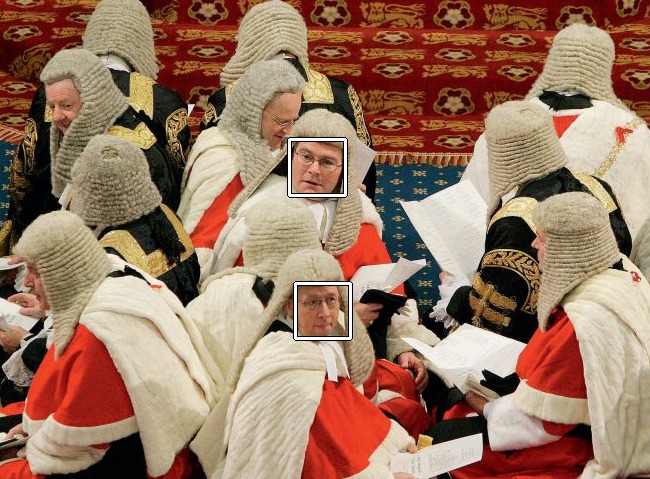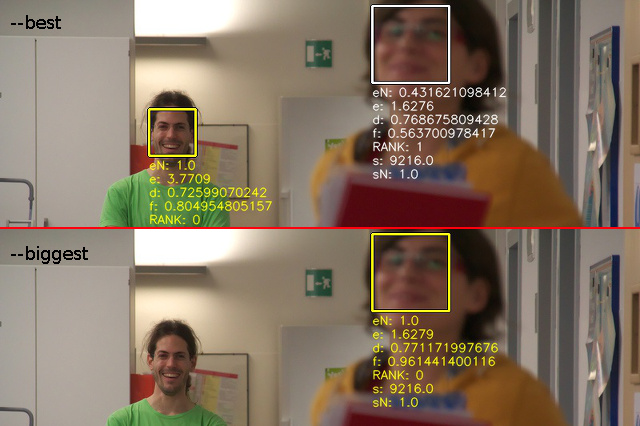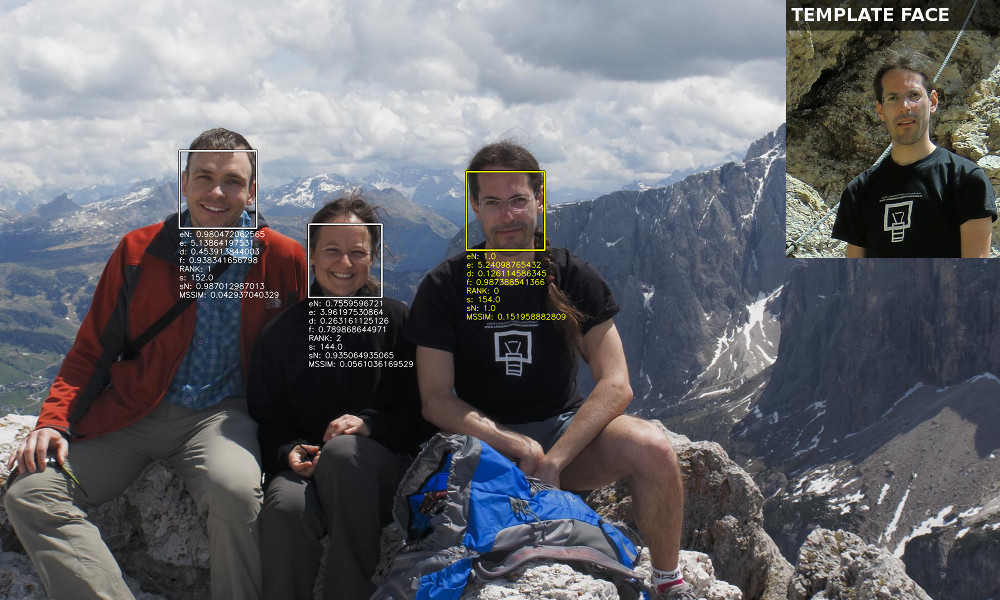facedetect: a simple face detector for batch processing

facedetect is a simple face detector for batch processing. It answers the basic question: “Is there a face in this image?” and gives back either an exit code or the coordinates of each detected face in the standard output.
The aim is to provide a basic command-line interface that’s consistent and easy to use with software such as ImageMagick, while progressively improving the detection algorithm over time.
facedetect is used in software such as fgallery to improve the thumbnail cutting region, so that faces are always centered.
Download
This project doesn’t have a fixed release schedule yet. All the relevant source/developer information can be found on Gitlab.
You can download the latest sources directly with:
Basic Usage
By default facedetect outputs the rectangles of all the detected faces:
./facedetect path/to/image.jpg 289 139 56 56 295 283 55 55
The output values are the X Y coordinates (from the top-left corner), followed by width and height. For debugging, you can examine the face positions directly overlaid on the source image using the -o flag:
./facedetect -o test.jpg path/to/image.jpg
To simply check if an image contains a face, use the -q switch and check the exit status:
./facedetect -q path/to/image.jpg echo $?
An exit status of 0 indicates the presence of at least one face. An exit status of 2 means that no face could be detected (1 is reserved for failures).
The --center flag also exists for scripting convenience, and simply outputs the X Y coordinates of face centers:
./facedetect --center path/to/image.jpg 317 167 322 310
The --biggest flag only outputs the biggest face in the image, while --best will attempt to select the face in focus and/or in the center of the frame.

Comparison between --best (top) and --biggest (bottom). The chosen face is highlighted in yellow.
Unless DOF or motion blur is used effectively by the photographer to separate the subject, --biggest would in most cases select the same face as --best, while being significantly faster to compute.
Examples
Pixelating faces automatically using facedetect and mogrify
Sorting images with and without faces
The following example sorts pictures into two different “landscape” and “people” directories using the exit code:
for file in path/to/pictures/*.jpg; do
name=$(basename "$file")
if facedetect -q "$file"; then
mv "$file" "path/to/people/$name"
else
mv "$file" "path/to/landscape/$name"
fi
done
Blurring faces within an image
The following example uses the coordinates from facedetect to pixelate the faces in all the source images using mogrify (from ImageMagick):
for file in path/to/pictures/*.jpg; do
name=$(basename "$file")
out="path/to/blurred/$name"
cp "$file" "$out"
facedetect "$file" | while read x y w h; do
mogrify -gravity NorthWest -region "${w}x${h}+${x}+${y}" \
-scale '10%' -scale '1000%' "$out"
done
done
Here mogrify is called for each output line of facedetect (which is sub-optimal), modifying the file in-place.
Extracting all faces to separate images
The following example uses convert from ImageMagick to extract each face in each source image img.jpg to a separated image img_N.jpg:
for file in path/to/pictures/*.jpg; do
name=$(basename "$file")
i=0
facedetect "$file" | while read x y w h; do
convert "$file" -crop ${w}x${h}+${x}+${y} "path/to/faces/${name%.*}_${i}.${name##*.}"
i=$(($i+1))
done
done
Searching for a face
facedetect has some naïve support to search for a specific face as supplied with the -s file argument. The file provided must be an image containing preferably a single face. facedetect will then compare all faces against it, and output only the matches which are above the requested similarity threshold (30% by default).

When face search is used with -q (query), and exit status of 0 is only emitted if there is at least one face matching the requested template.
The similarity threshold can be controlled with --search-threshold, which is a value between -100 and 100, with greater values resulting in greater similarity. The current matching algorithm is based on simple MSSIM which is far from perfect (see Development status and ideas).
Dependencies
The following software is currently required for facedetect:
- Python 3 or Python 2.7
- Python OpenCV >= 2.4 (python3-opencv or python-opencv)
- OpenCV data files (opencv-data if available, or libopencv-dev)
On Debian/Ubuntu, you can install all the required dependencies with:
sudo apt-get install python3-opencv opencv-data
and then install facedetect with:
sudo cp facedetect /usr/local/bin
Development status and ideas
Currently facedetect is not much beyond a simple wrapper over the Haar Cascade classifier of OpenCV and the frontalface_alt2 profile, which provided the best results in terms of accuracy/detection rate for the general, real life photos at my disposal.
In terms of speed, the LBP classifier was faster. But while the general theory states that it should also be more accurate, the lbp_frontalface profile didn’t provide comparable results, suggesting that additional training is necessary. If some training dataset is found though, creating an LBP profile would probably be a better solution especially for the processing speed.
haar_profileface had too many false positives in my tests to be usable. Using it in combination with haar_eye (and other face parts) though, to reduce the false positive rates and/or rank the regions, might be a very good solution instead.
Both LBP and Haar don’t play too well with rotated faces. This is particularly evident with “artistic” portraits shot at an angle. Pre-rotating the image using the information from a Hough transform might boost the detection rate in many cases, and should be relatively straightforward to implement.
Face matching has the interface that user’s expect (“find me this face”), but doesn’t work as it should. Faces are currently compared using pairwise MSSIM, which is a far cry from proper face segmentation. MSSIM will only find faces that have comparable orientation, expression and lighting conditions. HAAR features do not provide the positioning accuracy required to perform even the simplest face segmentation operations, such as inter-eye distance. Interestingly, computing a score using 1:1 SIFT feature matches performed even worse than plain MSSIM (not enough granularity in most scenarios). Building a GUI on top of facedetect to train SVM models (which can then be fed back to -s) seems a better way to go given the far greater accuracy, but somehow deviates from the original intention of unsupervised search.
Authors and Copyright
facedetect can be found at https://www.thregr.org/wavexx/software/facedetect/
facedetect’s GIT repository is publicly accessible at: